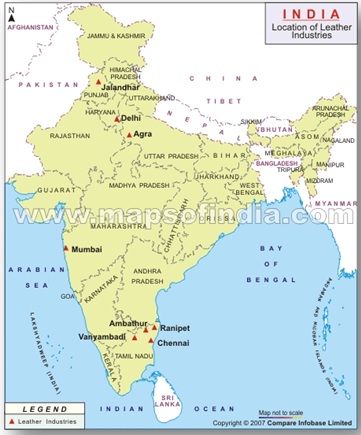

|
Syllabus : Prelims GS Paper I : Indian and World Geography-Physical, Social, Economic Geography of India and the World. Mains GS Paper I : Factors responsible for the location of primary, secondary, and tertiary sector industries in various parts of the world (including India) |
Context
Despite having a dominant position in the Indian economy, the leather industry is shrinking due to the deficiency of R&D.
This industry is slowly shrinking, as reflected by the figure of exports in 2014-15, from $ 6.2 billion to $ 4.8 billion in 2019-20, due to lack of interest in the R&D by major leather industry companies. It shows a continuously declining graph of leather exports. The situation has worsened by the COVID-19 epidemic, with exports dropping by $ 1.5 billion.
Leather Industry in India
The Leather Industry holds a very prominent place in the Indian economy and is one of the oldest manufacturing industries in India. It provides employment to about 2.5 million people in the country and has an annual turnover of approximately USD 5,000,000.
India is one of the best destinations in the world for investing in the leather industry because it is abundant with raw materials in the form of huge population of cattle. India accounts for 21% of the world's cattle and buffalo and 11% of the world's goat and sheep population.
Apart from the easy availability of raw materials, investors are able to enjoy easy and abundant supply of skilled manpower, world-class technology, competent and favourable environmental standards, and the devoted support of allied industries.
Leather Industry in India is a mixture of both the organized and the unorganized sectors. About 75% of the leather output in India is generated by the small, cottage and artisan sectors (unorganized). Leather making dates back to pre-historic age. However, the modern method of leather production was introduced to India by the English and the French in 1857.
Traditionally, the leather industry in India produces hides and skins. However, there are also the secondary leather industries such as leather shoes, leather garments and other leather goods such as ladies bags, gloves, travel cases, wallets, belts and desktops.
Over the years the leather industry in India has undergone drastic change from being a mere exporter of raw materials in the early 60's and 70's to now becoming an exporter of finished, value-added leather products.
The structure of the leather industry is spread in different segments, namely, tanning & finishing, footwear & footwear components, leather garments, leather goods including saddlery & harness, etc.
The major production centres for leather and leather products are located at Chennai, Ambur, Ranipet, Vaniyambadi, Trichi, Delhi, Dindigul, Kolkata, Kanpur, Jalandhar, Bangalore and Hyderabad.
Challenges of the Leather Industry
|
Leather Industry, Environmental Issues and Sustainable Solutions Leather Industry is recognised as a major polluting industry. It generates solid waste and industrial sewage at various stages of processing. Tannery waste contains chromium and other hazardous compounds which pose a major threat to the health and environment. When the waste is dumped into water systems, it can damage fish gills, incite respiratory problems, infections, infertility, and birth defects. It can also instigate a number of serious cancers. There is a need to revamp leather processing methods anew for the sustainability of the leather industry. Sustainability refers to the synchronised accomplishment of environmental, social, and economic balance. Tanneries are to be connected to wastewater treatment mechanisms. CSIR has come out with a game-changing “Waterless chrome tanning technology” for enabling the Indian leather sector achieve the set target of USD 27 billion by making leather processing environmentally sustainable by 2020. This is a first of its kind technology to reduce chromium pollution load. |
Major Initiatives to Boost the Leather Sector
Other Suggestions
Conclusion
The leather industry in India at the present time has a huge scope, immense base for leather products and easy availability of resources and its skilled workers, making it the best destination for investment to boost the work in R&D.
The global leather industry is in the process of shifting its manufacturing base from developed to developing nations. This provides an opportunity for increased flow of foreign direct investment (FDI) into India.
Connecting the dots
Question for Prelims
Which one of the following is not a centre of Leather Industry?
(a) Calcutta
(b) Agra
(c) Kanpur
(d) Jammu
Question for Mains
Discuss the challenges faced by the leather industry in India and suggest measures to address these challenges.

Our support team will be happy to assist you!
